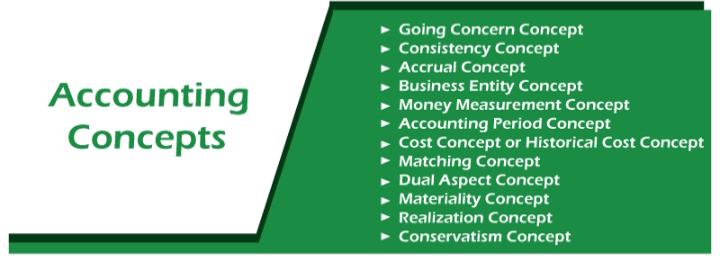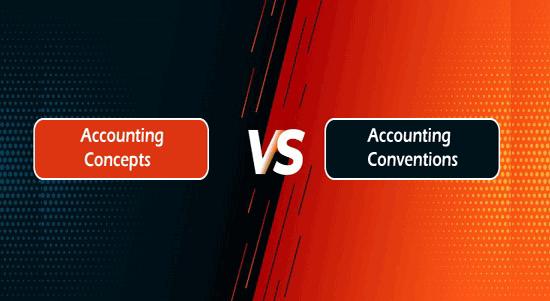Accounting ConceptsIntroductionVarious basic rules, assumptions, and conditions that define the parameters and constraints that are used to operate accounting are known as accounting concepts. These concepts form the fundamental basis for preparing financial statements. These principles or concepts are usually called 'Generally Accepted Accounting Principles' (GAAP). These concepts are accepted and used by accountants all over the world. Objectives of Accounting ConceptsAccounting concepts are helpful in making the accounting information meaningful to various parties, i.e., internal and external. Its various objectives are as follows:
Various Accounting Concepts
Some of the generally accepted accounting concepts are given below: 1. Going Concern ConceptGoing concerned is an accounting term that is used in the context of a company that is financially stable, can pay its dues on time, and continue the business for the foreseeable future. In the financial reports of such companies, certain assets and expenses may be deferred. In other words, a going concern is expected to have the following things working in its favor:
2. Consistency ConceptConsistency means that once accounting procedures have been chosen, they must be applied consistently in the future. For similar scenarios, the same tactics and techniques must be employed. It suggests that a company must not change its accounting policy unless there are compelling reasons to do so. The consistency concept is important for determining company patterns that span multiple accounting periods. The financial statements will not be comparable across accounting periods if the company continuously changes accounting procedures. 3. Accrual ConceptUnder this concept of accounting, the transactions are recorded in the books as they occur even if they are paid for a particular good or service that has not been received. This is a more appropriate method to assess the financial health of the company. This method is based on the matching principle, according to which revenues and expenses should be recorded in the same period. 4. Business Entity ConceptThis concept states that a business should be treated separately from its owners, managers, creditors, and others. This means there must a separate set of books for the business and all the transactions must be recorded from the business' point of view only. 5. Money Measurement ConceptAs per this concept, the company should record only those items in the books which can be expressed in terms of money. An event can never be recorded in accounting unless its effect can be calculated in monetary terms with accuracy. For example, quarrels between the production manager and sales manager, strikes of the workers, etc. can't be recorded in the books. To make the accounting records simple, relevant, homogenous, and understandable it is necessary to express them in a common unit of measurement and with the help of money, this problem can be solved as it helps in adding and dealing with various things of diverse nature. 6. Accounting Period ConceptEvery businessperson starts, the business with intends to continue indefinitely for a long period. Because of this, the true results of business operations can only be calculated at the time of the wind up of the company. But calculating the profit after such a long period will be of no means for all the parties. The users of financial statements need the results frequently. Thus, the entire life of the company is divided into time intervals generally, twelve months or a financial year. Apart from this, a company that is listed on the exchange is bound to publish a report of profitability and financial position quarterly. 7. Cost Concept or Historical Cost ConceptThe cost concept is one of the most important concepts in Economics. It is a payment made to acquire any goods or services. In simple terms, the cost concept is a financial valuation of resources, risks, materials, time, and utilities consumed to purchase the goods and services. From the point of view of an economist, the cost of manufacturing or producing something is the concept of opportunity cost. The cost concept has various types:
8. Matching ConceptTo determine the net profit correctly, this concept is highly useful. As per this concept, all costs which apply to the revenue of a particular financial year should be charged against that revenue to figure out the net profit from the business operations. For this purpose, both revenue and costs should be recognized. Some points should be considered at the time of matching the costs with the revenue which include the following:
9. Dual Aspect ConceptAs per this concept, every business transaction has a dual aspect. To put it another way, every business transaction has an impact on at least two accounts. If one account is debited, the other will receive a credit. The 'Double Entry System' is a method of documenting transactions twice. The two sides of the balance sheet are always equal because of this principle, and the following accounting equation is always proven: Assets = Liabilities + Capital Or Capital = Assets - Liabilities Numerically, if a transaction affects one side of the equation then it will also affect the other side of the equation or can cause an increase in one account and then decrease the other account of the same side so that the balance gets automatically equal. 10. Materiality ConceptAccording to this concept, the financial statements must show all the items that leave an important economic effect on the business. It gives the consent to disregard the other concepts in the event that the uncovered things are immaterial for the company's commerce and the endeavors included in recording them are not profitable. 11. Realization ConceptThis concept is related to the cost concept. According to it, the company should record the asset at cost until and unless the realization of its realizable value. 12. Conservatism ConceptAccording to this principle, the organization must develop and maintain a cautious book of accounts. Conservatism says that an organization will plan for any anticipated losses or expenses but will not forecast future revenue. Difference between Accounting Concepts and Accounting ConventionsIt is often seen that many people use accounting concepts and accounting conventions interchangeably, but there are quite differences in them which are described below: 
Advantages of Accounting Concepts
Limitations of Accounting Concepts
Next TopicVoucher in Accounting
|
 For Videos Join Our Youtube Channel: Join Now
For Videos Join Our Youtube Channel: Join Now
Feedback
- Send your Feedback to [email protected]
Help Others, Please Share










